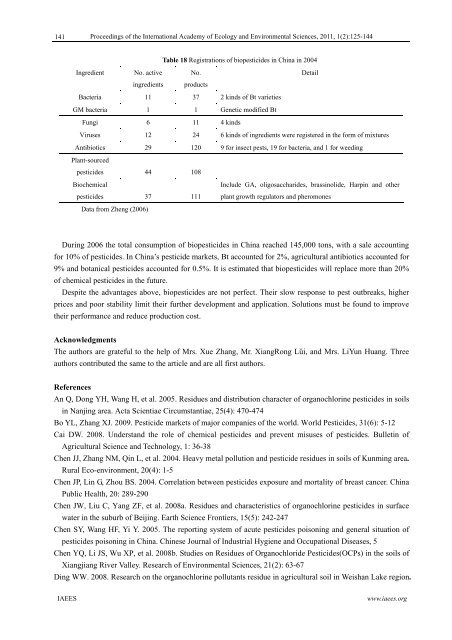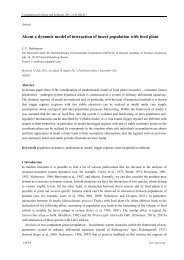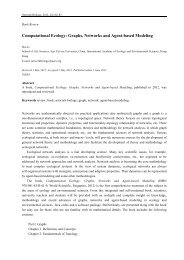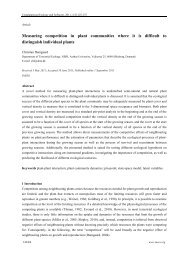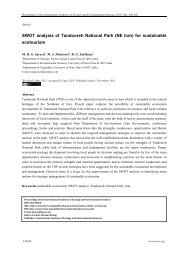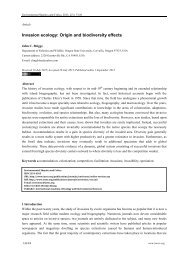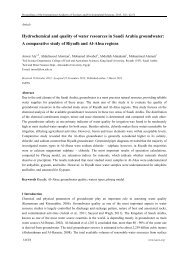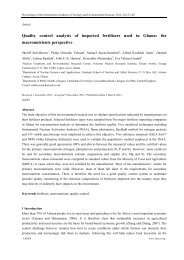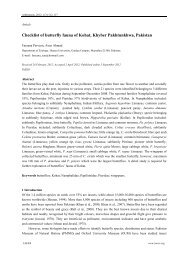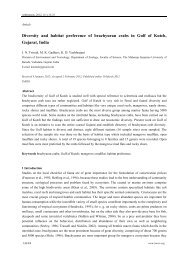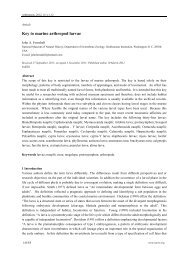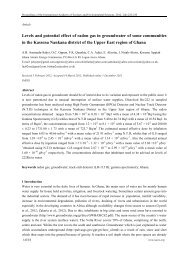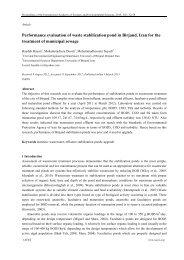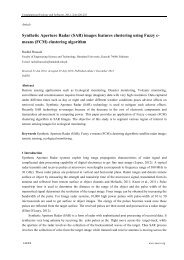Global pesticide consumption and pollution: with China as a focus
Global pesticide consumption and pollution: with China as a focus
Global pesticide consumption and pollution: with China as a focus
Create successful ePaper yourself
Turn your PDF publications into a flip-book with our unique Google optimized e-Paper software.
141<br />
Proceedings of the International Academy of Ecology <strong>and</strong> Environmental Sciences, 2011, 1(2):125-144<br />
Table 18 Registrations of bio<strong>pesticide</strong>s in <strong>China</strong> in 2004<br />
Ingredient<br />
No. active<br />
No.<br />
Detail<br />
ingredients<br />
products<br />
Bacteria 11 37 2 kinds of Bt varieties<br />
GM bacteria 1 1 Genetic modified Bt<br />
Fungi 6 11 4 kinds<br />
Viruses 12 24 6 kinds of ingredients were registered in the form of mixtures<br />
Antibiotics 29 120 9 for insect pests, 19 for bacteria, <strong>and</strong> 1 for weeding<br />
Plant-sourced<br />
<strong>pesticide</strong>s 44 108<br />
Biochemical<br />
<strong>pesticide</strong>s 37 111<br />
Include GA, oligosaccharides, br<strong>as</strong>sinolide, Harpin <strong>and</strong> other<br />
plant growth regulators <strong>and</strong> pheromones<br />
Data from Zheng (2006)<br />
During 2006 the total <strong>consumption</strong> of bio<strong>pesticide</strong>s in <strong>China</strong> reached 145,000 tons, <strong>with</strong> a sale accounting<br />
for 10% of <strong>pesticide</strong>s. In <strong>China</strong>’s <strong>pesticide</strong> markets, Bt accounted for 2%, agricultural antibiotics accounted for<br />
9% <strong>and</strong> botanical <strong>pesticide</strong>s accounted for 0.5%. It is estimated that bio<strong>pesticide</strong>s will replace more than 20%<br />
of chemical <strong>pesticide</strong>s in the future.<br />
Despite the advantages above, bio<strong>pesticide</strong>s are not perfect. Their slow response to pest outbreaks, higher<br />
prices <strong>and</strong> poor stability limit their further development <strong>and</strong> application. Solutions must be found to improve<br />
their performance <strong>and</strong> reduce production cost.<br />
Acknowledgments<br />
The authors are grateful to the help of Mrs. Xue Zhang, Mr. XiangRong Lȕi, <strong>and</strong> Mrs. LiYun Huang. Three<br />
authors contributed the same to the article <strong>and</strong> are all first authors.<br />
References<br />
An Q, Dong YH, Wang H, et al. 2005. Residues <strong>and</strong> distribution character of organochlorine <strong>pesticide</strong>s in soils<br />
in Nanjing area. Acta Scientiae Circumstantiae, 25(4): 470-474<br />
Bo YL, Zhang XJ. 2009. Pesticide markets of major companies of the world. World Pesticides, 31(6): 5-12<br />
Cai DW. 2008. Underst<strong>and</strong> the role of chemical <strong>pesticide</strong>s <strong>and</strong> prevent misuses of <strong>pesticide</strong>s. Bulletin of<br />
Agricultural Science <strong>and</strong> Technology, 1: 36-38<br />
Chen JJ, Zhang NM, Qin L, et al. 2004. Heavy metal <strong>pollution</strong> <strong>and</strong> <strong>pesticide</strong> residues in soils of Kunming area.<br />
Rural Eco-environment, 20(4): 1-5<br />
Chen JP, Lin G, Zhou BS. 2004. Correlation between <strong>pesticide</strong>s exposure <strong>and</strong> mortality of bre<strong>as</strong>t cancer. <strong>China</strong><br />
Public Health, 20: 289-290<br />
Chen JW, Liu C, Yang ZF, et al. 2008a. Residues <strong>and</strong> characteristics of organochlorine <strong>pesticide</strong>s in surface<br />
water in the suburb of Beijing. Earth Science Frontiers, 15(5): 242-247<br />
Chen SY, Wang HF, Yi Y. 2005. The reporting system of acute <strong>pesticide</strong>s poisoning <strong>and</strong> general situation of<br />
<strong>pesticide</strong>s poisoning in <strong>China</strong>. Chinese Journal of Industrial Hygiene <strong>and</strong> Occupational Dise<strong>as</strong>es, 5<br />
Chen YQ, Li JS, Wu XP, et al. 2008b. Studies on Residues of Organochloride Pesticides(OCPs) in the soils of<br />
Xiangjiang River Valley. Research of Environmental Sciences, 21(2): 63-67<br />
Ding WW. 2008. Research on the organochlorine pollutants residue in agricultural soil in Weishan Lake region.<br />
IAEES<br />
www.iaees.org


